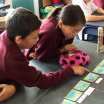Build language-rich environments
Create an environment that extends and supports language growth.
On this page:
On this page:
Current page section: Build language-rich environments
Go to top of current page: Build language-rich environments
Go to top of current page: Build language-rich environments
Go to top of current page: Build language-rich environments
Develop language-rich displays
Develop language-rich displays
Create displays that extend children’s language growth. Regularly refresh the displays in collaboration with ākonga and whānau.
Ideas for creating rich language environments include:
- Display big ideas with visuals.
- Use zones, for example, for inquiry, English and maths, to make it easy to find key supports.
- Use images, photos and displays to prompt language-rich conversations.
- Include photos of shared activities such as field trips to prompt ongoing discussions.
- Create vocabulary and word walls. Keep them uncluttered. Refresh them to reflect current topics.
- Use pouches, resource boxes, photos or QR codes so students can take resources to their desks or personal devices.
- Make spaces that are unique to Aotearoa, for example, spaces for te ao Māori and te reo Māori that are prominent and integrated across all areas.
- Create displays that give ākonga access to key vocabulary, task steps, success criteria, thinking tools and models.
Respond to language needs and interests
Respond to language needs and interests
Komal Singh, a new entrant teacher at Wiri Central School, talks about how she has responded to ākonga language needs and interests using visuals, wall displays, class-made books and commenting.
Download video transcript.
Source: Ministry of Education Te Tāhuhu o te Mātauranga
Closed Captions
Develop language-teaching strategies
Develop language-teaching strategies
Extend thinking and support conversations using the oral language strategies in Talk Tools on Te Whariki Online.
Use comments to build language
Use comments to build language
The one-hand rule suggests four comments to each question.
Use narrative approaches
Use narrative approaches
Telling and listening to stories are key components of language learning. Invite ākonga to tell their own stories, use prompts and read back stories. Collating student work into a book, means students can revisit language and narratives.

Source: Ministry of Education | Te Tāhuhu o te Mātauranga
Extend language through play
Extend language through play
Use play, role play and games to provide authentic opportunities for ākonga to interact with others and practise being a good communication partner.

Source: Ministry of Education Te Tāhuhu o te Mātauranga
Build topic-specific vocabulary
Build topic-specific vocabulary
Use techniques that help students learn, understand and use key vocabulary related to a topic.
Download the video transcript as a PDF:
Source: Ministry of Education Te Tāhuhu o te Mātauranga
Closed Captions
Next steps
More suggestions for implementing the strategy “Helpful classroom strategies years 1-8”:
-
Current page Build language-rich environments
Return to the guide “Speech, Language and Communication”

Speech, Language and Communication
How to use this site
Guide to Index of the guide: Speech, Language and Communication
Strategies for action:
-
Identify needs and how to provide supportShow suggestions for Identify needs and how to provide support
-
Key areas to supportShow suggestions for Key areas to support
-
Helpful classroom strategies years 1-8Show suggestions for Helpful classroom strategies years 1-8
-
Helpful classroom strategies years 9-13Show suggestions for Helpful classroom strategies years 9-13


